 |
| Category: Flags |

|
|
|
|
|
|
The Calgary
Highlanders |
|
are a Canadian Armed
Forces Land Reserve Infantry unit.
Since 1910, the
Regiment has served in Calgary, sending soldiers overseas during both
World Wars and on numerous UN peacekeeping and NATO missions since the
end of World War Two. |
| The use of flags for
recognition of the combatants on a battlefield dates back to antiquity.
The use of flags, or Colours, in the Canadian Army today is purely
ceremonial, however their importance to the morale and espirit de corps
of individual Regiments of Infantry cannot be underestimated.
The use of Colours in the British Army
extends to well before the mid 1700s, yet it was the "Regulations
for the uniform Clothing of the Marching Regiments of Foot, their
Colours, Drums, Bells of Arms, and Camp Colours" published in 1747
that marked their use in the modern sense. |
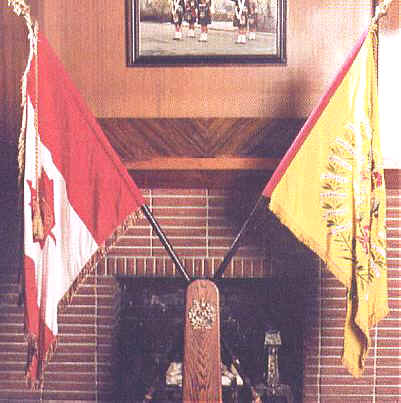 |
| Prior to this time,
commanders of individual Regiments (called Colonels) were free to place
their own personal heraldic devices on flags and other devices on units
under their command.
The ties an Infantry Regiment had to
their Colonel in this period were extensive, as it was often he who paid
for and equipped the unit. In addition to using his own device on
regimental flags, the regiments were named for him. For example
"Howard's Regiment" would be a regiment led by a Colonel
Howard.
|
| Uniforms were much more
elaborate at this period, and regiments were distinguished in many ways,
including badges worn on cap and collar, patterns of lace worn on the
tunic, and the "facing colour." Military jackets of the
time were lined in a contrasting colour to the outer colour (usually
scarlet in infantry regiments, excepting rifle regiments). The
facing was usually revealed where the inside of the jacket was visible,
for example on the lapels, or on the sleeves, which were sewn long, then
turned back and buttoned in place, exposing the lining. Each
regiment selected its own facing colour. This was one of the
easiest ways to identify a unit on a battlefield at any great distance.
While other units have used flags,
with the exception of Guidons used by Cavalry and modern Armoured
Regiments, none have had the official status of the Colours of an
Infantry Regiment. In days of old, the Colours were considered a
Regiment's most prized possession, and loss of the Colours was an
unbearable disgrace. Many British soldiers sacrificed their lives
in defending their Colours, or attempting to recapture Colours that had
been lost in battle.
1747 Regulations
The use of flags at this point in time
still served a very tactical purpose; the flags were carried into battle
and used to identify a regiment's positions and also to mark a rallying
point should the regiment become disrupted in battle. Therefore,
the 1747 regulations attempted to codify the use of flags in order to
standardize their appearance and ensure that they continued to be a
useful means of identifying friendly troops.
From this point on, then, a
"stand of Colours" came to refer to two flags as carried by a
single Regiment of infantry. (As regimental organizations
changed over the years, and these Regiments began to be split into
multiple battalions, each battalion would receive its own stand of
colours).
King's Colour
(or Queen's Colour) - referred to in the 1747 Regulations also for the
first time as the First Colour; this flag identified the battalion as
belonging to the British Army and represented loyalty to the reigning
sovereign. The design of the flag was the Great Union flag.
Regimental Colour
- this flag, also referred to in
the 1747 Regulations as the Second Colour, was considered junior to the
King's Colour. It identified the Regiment to which the battalion
belonged. The flag was generally to be in the "facing
colour" of the Regiment so as to be easily identifiable. By
regulation, the Union flag was to be placed in the upper canton.
Each colour was to be decorated with
Roman numerals in gold, either painted or embroidered, indicating the
Rank of the Regiment, within a wreath of Roses and Thistles on the same
stalk (representing the Union of Scotland and England) on a scarlet
field.
Changes to the Design
In 1784, the modern tradition of
emblazoning Battle Honours on the Regimental Colour began, when those
units that served at Gibraltar were permitted to add the title GIBRALTAR
to their Regimental Colours. As time went on and Battle
Honours became standardized, they took the form of inscriptions or as
scrolls. As well, other significant devices were added as years
went on, such as the Sphinx device for units rewarded for service in
Egypt. The Sphinx was also added to cap badges, collar badges and
belt buckles of some Regiments to honour their service there.
In 1801, the second pattern Union Flag
(with the Cross of St. Patrick laid over the St.Andrew's Cross) was used
in the design of British Infantry Colours. Union with Ireland also
brought the addition of shamrocks to the wreath on the Regimental
Colour. |
| At right, the Regimental
Colour of the 93rd Sutherland Highlanders, predecessors of the Allied
Regiment, The Argyll and Sutherland Highlanders (Princess Louise's), as
they appeared from 1834-1857.
Per custom, the Union Flag is visible
in the upper canton, and the wreath contains the English Rose, Scottish
Thistle, and Irish Shamrock. The rank of the regiment is indicated
by the Roman numerals XCIII (93).
The background is "old gold"
or yellow - the facing colour of the 93rd Highlanders.
|
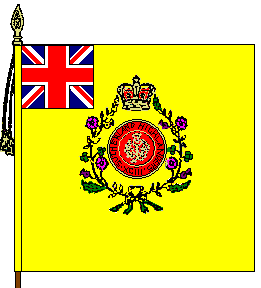 |
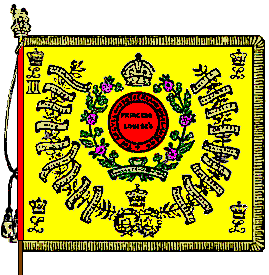 |
By 1926, the modern
Regimental Colour had evolved into something resembling the artist's
conception at left. This Colour was carried by the Second
Battalion, The Argyll and Sutherland Highlanders (Princess Louise's).
The spear-top has been replaced with a
standard Crowned
Lion on Crown.
The facing colour, yellow, still provides the field, and the unit
designation is still found on a scarlet disc. However, the Union
Jack has disappeared, in favour of regimental symbols - in this case the
insignia of Princess Louise. |
| The Argylls were permitted
to carry the Battle Honours of both the old 91st and 93rd Regiments,
after the amalgamation of the two units in 1881. The insignia of
both regiments may be seen at the bottom of the Regimental Colour, and
formed the basis of the collar insignia worn by the Regiment.
The flag is also edged in gold fringe, today generally indicative of a
military flag.
The Battalion is represented by the
Roman Numeral "II" in the upper corner. The First
Battalion would have carried an identical Colour, with the number
"I".
As Canadian Infantry regiments were
created after Confederation, they too were presented stands of Colours,
patterned after British regulation.
With the creation of the new Canadian
National Flag in 1965, Queen's Colours were to henceforth be patterned
after this flag rather than the Union Jack.
Exceptions
The number of exceptions to the
regulations mentioned above are too numerous to list, though Guards
Regiments are notable for having Company Colours rather than Regimental
Colours. Rifle Regiments, whose traditions revolve around the idea
that their unit relies on stealth and individual initiative, have no
Colours as such and instead wear their Battle Honours on their cap
badges. |
|
Colours
of The Calgary Highlanders and Predecessor Units |
| 103rd Regiment
(Calgary Rifles)
By 1910, Infantry Regiments no longer
carried their Colours into battle. Being a Rifle Regiment, the
103rd Calgary Rifles never received a stand of Colours in any event.
Having no Battle Honours, the cap badge also remained unadorned.
10th Battalion, Canadian
Expeditionary Force
When the Canadian Militia mobilized
units for active war service, the force known as the Canadian
Expeditionary Force was made up entirely of numbered battalions.
Officially, these numbered battalions were to have no connection with
the existing Regiments, though in practice many of the new battalions
took such Regimental accoutrements into use as tartans, cap badges and
other traditional uniform components. Some of the battalions had
King's and Regimental Colours also, including reinforcement battalions
created in Canada.
 |
The Tenth Battalion,
however, did not have its own Colours. In 1917 the battalion
was authorized to have a "battle flag", in red with a
white circle bearing the distinguishing patches as worn on the
uniform sleeves upon it.
It is not, however, known
whether or not the battalion ever adopted such a flag. |
| Its
only use would have been as a headquarters marker in any event.
For the march into Germany in December 1918, the Tenth Battalion
was issued a wool bunting Union Jack, of the same type issued to
all Canadian battalions not in possession of their own Colours. |
|
| The Union Jack was
deposited in Knox Church in Calgary on 19 July 1919, and the Church
offered to present a Regimental Colour to accompany the Union Jack now
referred to as the King's Colour. The Tenth Battalion Association
politely refused, wanting to wait until Battle Honours had been granted.
For long years after the award of
Battle Honours in 1929, nothing was done, until finally the Tenth
Battalion Association decided to purchase new Colours at their own
expense in 1950. The Department of National Defence granted
permission, so long as no expense to the public was incurred. The
original King's Colour could, according to DND, either be left
undisturbed in its resting place at Knox Church, deposited elsewhere in
the Church, or cremated with the ashes being spread over the replica as
part of the ceremony of depositing the new Colours.
The Association opted to cremate the
original King's Colour, and the order for the new Colours was placed in
late 1952, with delivery being taken in March 1953. On 26 April
1953, the new stand of Colours was officially deposited at Knox Church,
in a ceremony involving 62 veterans of the Tenth Battalion accompanied
by the Regimental Pipes and Drums of The Calgary Highlanders. The
Colours still reside today at Knox Presbyterian United Church in
downtown Calgary. |
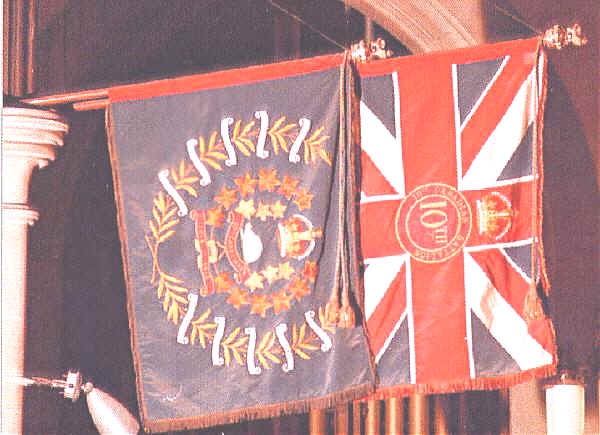 |
| 56th Battalion, CEF
In all, 260 infantry battalions were
raised during the First World War for inclusion in the Canadian
Expeditionary Force, though only a fraction of them were used for active
service, the remainder usually broken up for reinforcements of the
active CEF units. Nonetheless, enthusiastic units created cap,
collar and shoulder badges for themselves, and eagerly adopted the
traditions of founding regiments in some cases. The 56th
Battalion, one of two reinforcement battalions perpetuated by The
Calgary Highlanders, funded a stand of Colours in March 1916. The
Colours were deposited at the Church of the Redeemer in Calgary where
they still reside.
82nd Battalion, CEF
The 82nd Battalion also had a stand of
Colours, which were presented in May 1916, then deposited at St. Mary's,
Sellindge, Kent in the United Kingdom in June 1916. They were
eventually transferred to the Glenbow Museum in Calgary in 1965.
The Calgary Highlanders
The first stand of Colours belonging
to The Calgary Highlanders were presented on Wednesday, 28 December
1927.
According to tradition, the King's
Colour was based on the Union Flag, with a red disc in the centre
bearing a gold numeral I and the legend THE CALGARY HIGHLANDERS.
The Regimental Colour had a yellow field, the facing colour inherited
from the Allied regiment, The Argyll and Sutherland Highlanders
(Princess Louise's). The red disc on the Colour bore a regimental
symbol, the St. Andrew's Cross (a common feature of Highland and
Scottish regiment badges) surmounted by the beaver. The beaver had
been the central symbol on the cap badge of the Tenth Battalion,
symbolizing Canada, and was also included on the cap badge of The
Calgary Highlanders. As per Canadian custom, the wreath of roses,
thistles and shamrocks found on British Army Colours was replaced by a
wreath of Canadian maple leaves. The battalion numeral
"I" was located in the top canton.
Battle Honours for the First World War
had not yet been granted, and so the Colours were blank at first.
Subsequently, the Battle Honours awarded to the Calgary Highlanders,
earned by the predecessor unit, the Tenth Battalion, and selected for
emblazonment, were added to the Regimental Colour. |
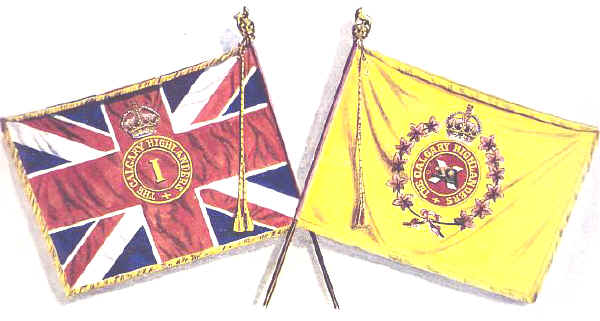 |
|
Artist's concept of the 1927 stand
of Colours, as used in the presentation programme.
Scan courtesy Lieutenant Kevin S. Winfield, CD
On 29 March 1940, the Colours were
officially deposited in the Cathedral of the Redeemer for safekeeping,
until the overseas battalion of The Calgary Highlanders returned to
Canada.
On Thursday, 25 May 1967, a new stand
of Colours was presented by Her Royal Highness Princess Alexandra of
Kent in a ceremony held at Currie Barracks in Calgary. The new
Queen's Colour had the St. Edward's Crown rather than the Tudor Crown as
worn on the older King's Colour, and the new Regimental Colour was
emblazoned with the Regiment's Second World War Battle Honours. The
new Colours also deleted the Roman numeral "I" indicating the
First Battalion. The old Colours were subsequently deposited
in the Cathedral of the Redeemer in Calgary. Also on parade was
the South Alberta Light Horse, who received a new Guidon in a dual
ceremony. |
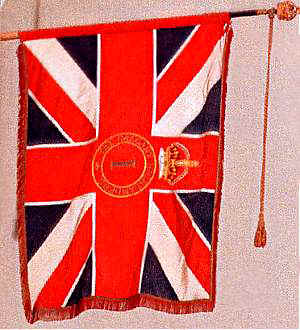 |
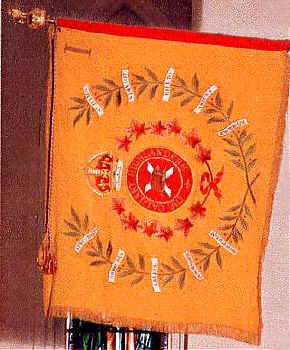 |
| The
stand of Colours retired in 1967, as they now appear at the Cathedral of
the Redeemer. Note the Tudor or "King's" Crown on both.
These were replaced by the St. Edward's or "Queen's" Crown on
the new Colours presented by HRH Princess Alexandra of Kent. |
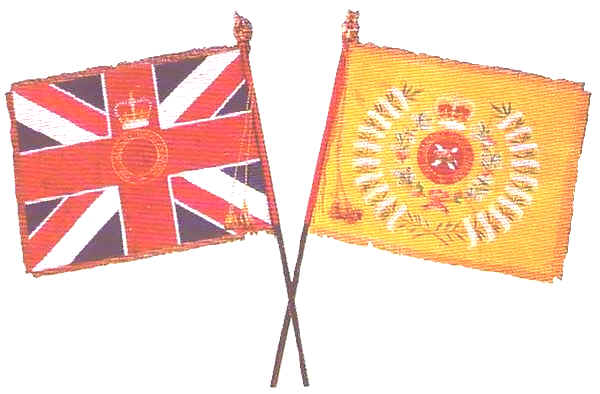 |
|
Photograph of the new
stand of Colours presented in 1967.
Scan courtesy Lieutenant Kevin S. Winfield, CD |
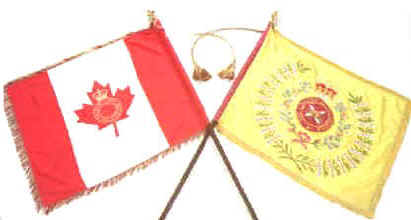 |
This Queen's Colour, still
patterned on the the Union Jack, was replaced by a new Queen's Colour
based on the maple leaf National Flag on 30 June 1990.
The presentation was made by Her
Majesty Queen Elizabeth II, Colonel-in-Chief of the Regiment, at McMahon
Stadium in front of 38,000 spectators. |
| Also on parade was the
King's Own Calgary Regiment. Above, the current stand of Colours,
including the Queen's Colour presented in 1990 and the Regimental Colour
presented in 1967. |
| The Regiment has also adopted
in recent years a "Camp Flag", as shown at right.
This is not an official Colour and is used in an unofficial
manner only.
It may be flown daily at the
home station, or wherever the Regiment is stationed, from sun
up to sun down.
|
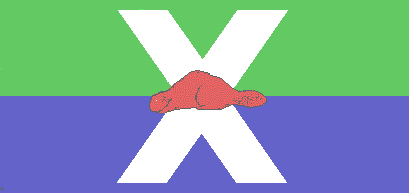 |
The Camp Flag has also been used by
the Pipes and Drums while on parade or at Highland Games. A
Regimental Camp Flag also flies over the Museum of the Regiments in
Calgary. |
|
From http://www.calgaryhighlanders.com |
|